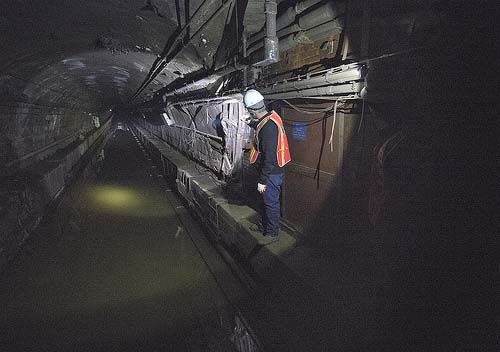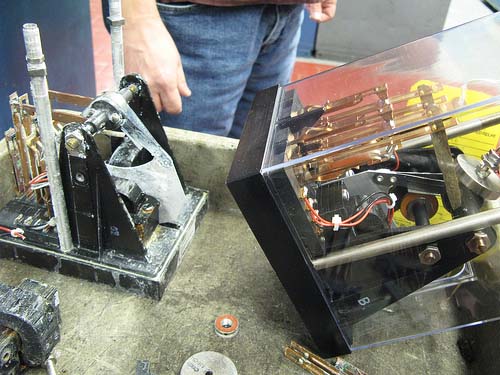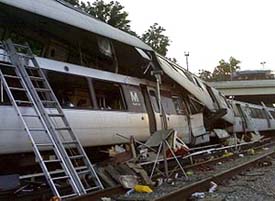It took just short days before New York’s subways overcame the assorted horrors of ‘Frankenstorm,’ Superstorm Sandy’s turning subway tunnels into horizontal saltwater silos proving nothing that could stop NY. But just after Sandy struck, Bloomberg News headlined “New York Subway System Faces Weeks to Recover From Storm,” the story observing that many of the Subway’s key electrical systems “can be ruined by salt,” leading to a “short circuit.” In the same article section, titled “Saltwater Damage,” the piece observed that “such a failure caused the deadliest crash in the history of Washington’s Metro system in 2009.”

MTA employees using a pump train are working around the clock to pump seawater out of the L train's tunnel under the East River. The tunnel was flooded during the unprecedented 13-foot storm surge of Hurricane Sandy. This photo shows activity on the afternoon of Monday, November 5. After the tunnel is pumped dry of water, work will begin to inspect tracks, signals, switches, electrical components, and third rail. If any repairs are needed, employees will make them as quickly as possible to get service restored. (MTA Caption) Photo Credit: Metropolitan Transportation Authority / Patrick Cashin. MTAPhotos
While I don’t doubt the resourcefulness and genuinely courageous efforts of New York’s Metropolitan Transit Authority (MTA) and its workers, I do wonder just how many ‘shortcuts’ might have been taken, especially when The New York Times reported MTA “officials at times alternating between a compulsion to cling to protocol and to toss it aside.” I’ll add that, according to The Times, the L train tunnel (pictured above) contained water that “stretched 3,400 feet and was 15 feet deep.”
The Times article, “New York Subway Repairs Border ‘on the Edge of Magic’,” also observed that MTA repair strategy often seemed to rotate upon one question—“Well, what works?” And, in a time when Mayor Bloomberg repeatedly cited the economic benefits of the New York Marathon before finally cancelling it, there do seem questions about prioritizing business issues over human ones, with little doubt as to the business losses a shutdown subway meant. With even the Times article noting subway service returned “quicker than almost anyone could have imagined,” maybe it might be worthwhile to consider why.
Yes, all of New York is rejoicing in its subways returning—I certainly don’t doubt the hardship many ordinary people have without them—and I certainly don’t mean to ‘rain on the parade’ here, but maybe there was a reason why most experts thought repairs would take far longer.
Bloomberg’s article had sought the opinion of a gentleman by the name of Mortimer Downey, someone who indeed seems knowledgeable upon the issues, reporting:
“Thousands of connections in signal systems will need to be cleaned and tested before trains can run again,” said Mortimer Downey, a former MTA executive director and current board member of the Washington Metropolitan Area Transit Authority.
“It’s an enormous amount of wiring and an enormous amount of connections that go to what’s called relay rooms,” Downey said. “They’ve got to turn the system on, and if it seems to be working I think they’ve got to go to every component and check it and get rid of all the salt. What you don’t want is a short circuit that causes the system to fail.”

Damaged vs. Pristine Condition: An example of subway signaling components that were damaged as a result of flooding during Hurricane Sandy. Photo taken at the 207th Street Yard in Upper Manhattan. (MTA Caption) Photo Credit: Metropolitan Transportation Authority / Deirdre Parker. MTAPhotos
In contrast, The Times description of what needed to be done stated:
“And even if tunnels were pumped, obstacles remained. Workers had to inspect tracks, third rails and signals. There could be no dangerous debris in the tunnels. Some cables needed to be reattached.”
While it’s natural that any two articles on the same subject will focus somewhat differently, if every electric component hadn’t been inspected, all salt removed, it would have saved a lot of time. Of course, if they did inspect every component, remove all the salt, then I guess it was just bad luck that led The Times to report “unexpected third-rail and switch problems” at one station, and that a G line “transformer blew,” delaying that line’s restarting.
While the imperatives of getting NY’s subways working are apparent to all, the 2009 Washington Metro crash is worth recalling, for many reasons. Aside from the nine dead and about eighty injured (some of the injured trapped for hours), Wikipedia notes that the National Transportation Safety Board (NTSB) found that “a faulty track circuit, part of the automatic train control system,” had caused the crash. It was further noted that the NTSB found that the circuit in question “had been malfunctioning since 2007, 18 months prior to the collision.”
I personally don’t believe in magic, and while I may be biased, I do hope New York’s officials, and its millions of subway riders, might be just a little hesitant to believe in it as well.
Copyright © 2012 Ritt Goldstein. All rights reserved.
Ritt Goldstein is an American investigative political journalist living in Sweden. His work has appeared fairly widely, including in America’s Christian Science Monitor, Spain’s El Mundo, Sweden’s Aftonbladet, Austria’s Wiener Zeitung, and a number of other global media outlets.




How many billions are NOT going to be spent between now and next year to prepare for what is certainly coming?